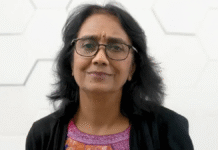Rare diseases often occur in childhood but when it strikes in adulthood, life takes a different course. For Merpati, a school teacher, husband, and father, the burden of Fabry disease was a heavy blow but one he chooses to bear with grace and acceptance.
A warm, sunny climate and an abundance of delicious food sounds like paradise to many. However, when hot weather leads to muscle cramps or fainting spells and kidney failure limits what you can eat, the picture becomes far less idyllic.
This is what Merpati Ahmad, a 48-year-old school teacher, faces due to a rare disease known as Fabry disease. It is caused by a deficiency in the enzyme alpha-galactosidase-A, which plays a role in breaking down fat. Without it, fat builds up in the body’s cells, leading to complications like kidney failure, heart failure, and stroke.
It is more common in men and symptoms include burning pain in the arms and legs which gets worse in hot weather, poor blood circulation, problems with the gastrointestinal system, progressive kidney disease that can lead to kidney failure, and enlargement of the heart that can lead to complications like heart failure and stroke.
Rare diseases are often difficult to detect as there are over 6,000 types and medical knowledge, expertise and care in these conditions is lacking – in Malaysia, there are only 13 rare disease specialists and 12 doctors in genetic clinics to care for patients across the country. As most doctors and nurses are unlikely to encounter a rare disease patient in their lifetime, it may take months or even years for patients to receive a diagnosis.
This can further delay treatment and, as most rare diseases are degenerative, the patient’s condition may worsen, leading to a negative impact on their wellbeing and quality of life.
For Merpati, the journey to a diagnosis took several years. While blood tests in 2008 revealed that he had high protein content in the urine, a sign of kidney disease likely caused by Fabry disease, he was only diagnosed with Fabry disease in June 2016 and received his first treatment in December 2018.
“By this time, I had symptoms like water retention with swollen feet. I often felt tired and I would get sick easily with a high fever,” explained Merpati. “When the doctor told me I had something called Fabry disease, I had never heard of it before. In fact, I was quite shocked. There were so many questions in my mind – how did I contract this disease? How am I going to face it? Can I afford it? As a husband and father, it also made me wonder, would I be able to live to a ripe old age and see my children grow up?”
Naturally, the first person he shared this news with was his wife, and the news was a heavy blow. However, despite her sorrow, she urged Merpati to be strong.
“I find it difficult to bear it when the weather is hot – I am easily tired and I may experience muscle cramps or even faint,” he explained. “This makes it a challenge for me but my colleagues have been understanding and I can continue to teach physical education by requesting lessons before 11 am, before it gets really hot. And when we go for family holidays, I have to let my family carry on with their activities when it gets hot while I find shelter. It is not ideal but it is what we need to do. We try to view this whole experience as part of life’s test for our family.”
To treat Fabry disease, Merpati receives weekly enzyme replacement therapy (ERT) which provides the enzyme his body needs, helping to reduce the build-up of fat, reduce pain, and prevent further organ damage. He finds that, since beginning treatment, he doesn’t fall sick as easily as before.
Administered intravenously, each session takes around three hours. Together with dialysis, which he now receives twice a week, he has to spend around 30 hours at the hospital every month.
Despite all these adjustments to his life, his greatest concern is being able to pay for treatment as treatment for rare diseases are not commercially viable and often too costly for private individuals to bear without financial assistance.
“Treatment for my condition is very expensive and costs around RM100,000 a year. Even as a working adult, I couldn’t afford that myself but I have been fortunate to receive aid from the Ministry of Education, although I do not know how long this will be available to me,” said Merpati. “The doctor tells me that, with consistent treatment, the dosage will be gradually reduced. I feel some improvement after each therapy and I hope this will continue so I can live a normal life.”
Hope for patients with rare diseases
To help other patients with rare diseases, experts and patient groups are advocates for measures such as newborn screening to help with identifying patients at an earlier stage, improved allocation of funds to make treatment more affordable, and training of more healthcare experts to recognize and treat rare diseases.
Such measures would help to ease the burden on parents or caretakers, as many patients presently face a long road to diagnosis, during which time they undergo emotional stress and uncertainty while bearing the cost of seeing multiple specialists and undergoing numerous tests in search of an answer, not to mention the continued worsening of the patient’s condition.
For Merpati, he is grateful that he is able to receive treatment as well as support and understanding from family, friends, and colleagues. However, he believes much more needs to be done for rare disease patients.
“I think family support is very important for someone like me who suffers from a rare disease. Without it, we would become easily depressed and just give up. However, with family support, we will feel more positive and not dwell on negative thoughts. This can be a good example for our friends and extended family, so this is my advice to anyone who finds themselves in my position – to be strong and positive so that we do not become a burden to others, even as we work towards goodness and find more ways to support others with rare diseases.”
If you or someone you know is experiencing symptoms of Fabry disease, speak to a health expert. You can also find more information and support through organizations such as the Malaysia Lysosomal Diseases Association (MLDA, https://www.mymlda.com/) and the Malaysian Rare Disorders Society (MRDS, http://www.mrds.org.my/).
















